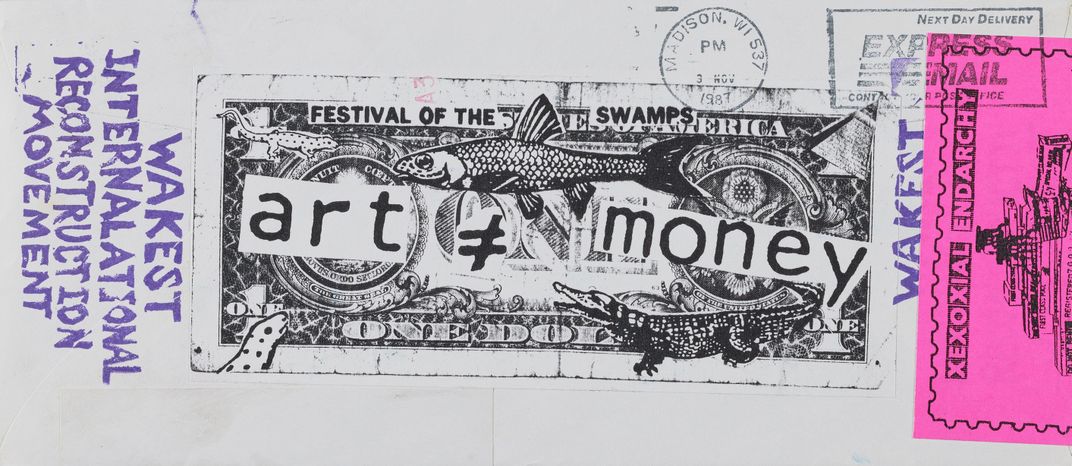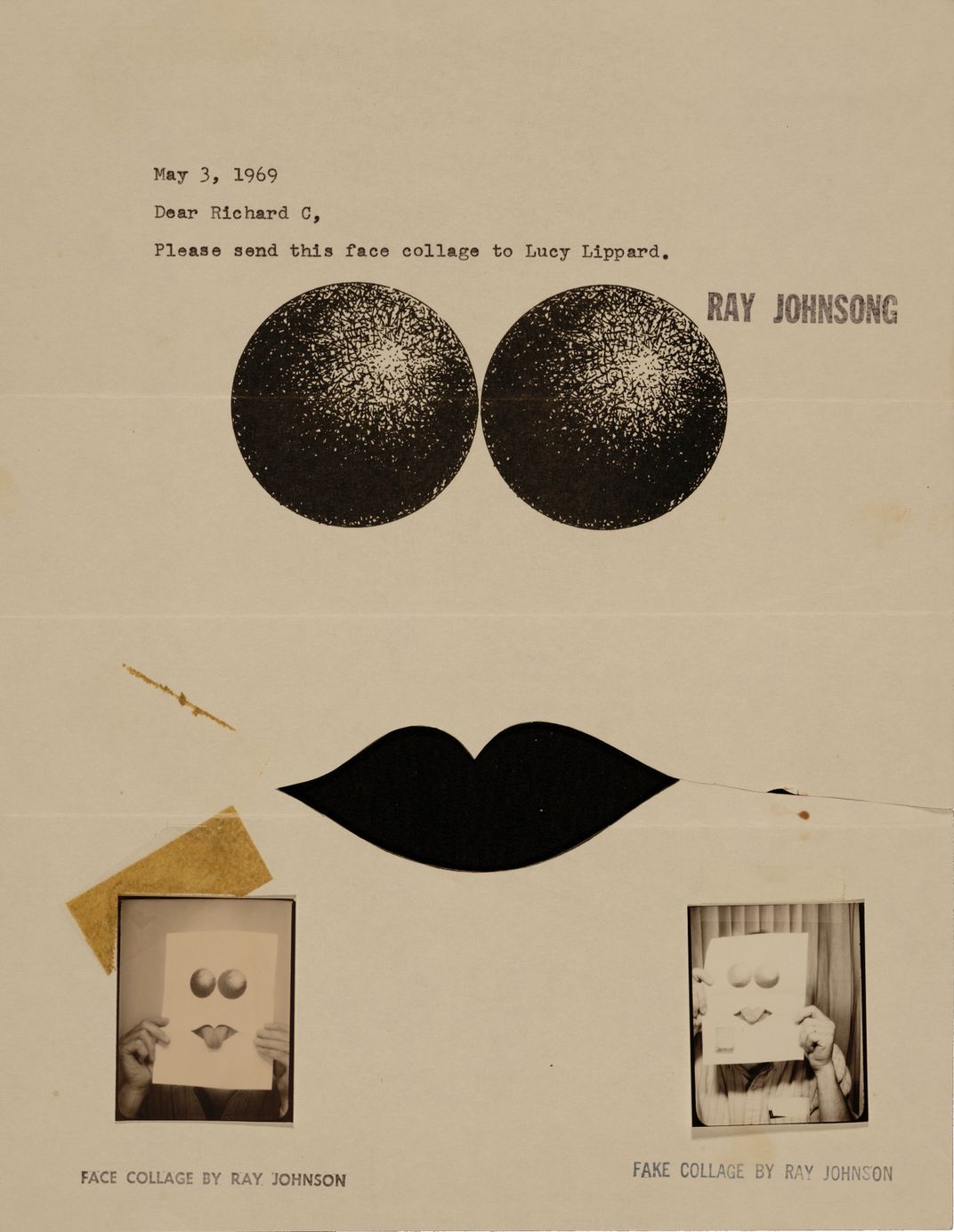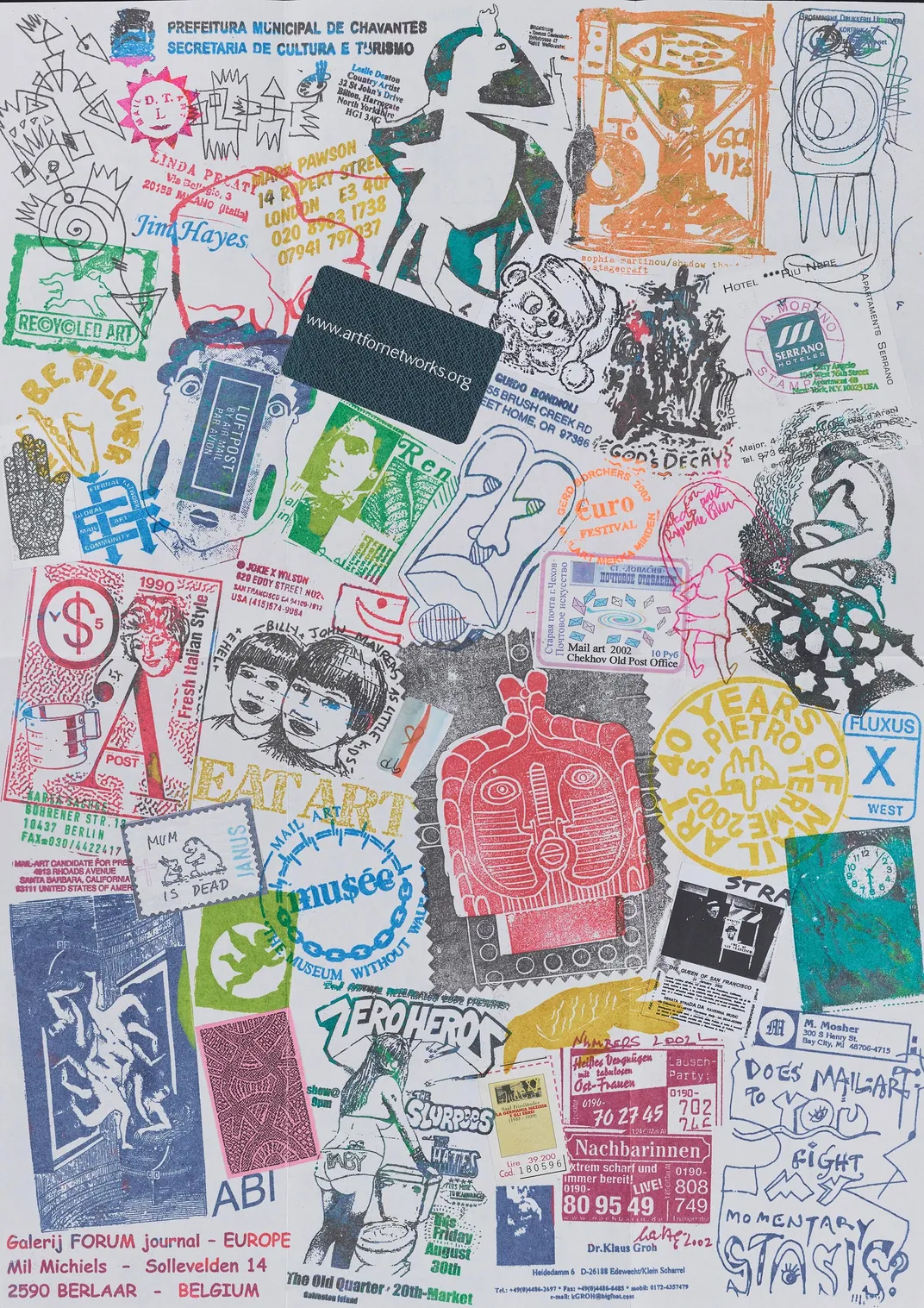Collaborative “Mail Art” Puts the Post in Postmodernism
Letters, envelopes and enclosures take center stage in an intimate new art show
:focal(1167x834:1168x835)/https://tf-cmsv2-smithsonianmag-media.s3.amazonaws.com/filer/ec/00/ec00b737-261e-4478-8dea-0514a94d0c82/mail2.jpg)
In the era of instant messaging and FaceTime on the go, it can be easy to forget the pleasure of shuffling out to the mailbox in hope of discovering a thoughtful note from an old friend. Removing a letter from its envelope is a rich tactile experience, and marginalia, cross-outs, distinct penmanship and quirky enclosures combine to give epistolary exchanges a uniquely personal flavor.
In the experimental artistic simmer of the late 1950s, the everyday creativity of letter-writing gave rise to a veritable movement: that of “mail art,” an antiestablishment, anything-goes mode of serial imaginative expression whose inclusive nature has kept it alive even into the Digital Age. Now a new show, “Pushing the Envelope,” organized by the Smithsonian's Achives of American Art and opening August 10 at the Lawrence A. Fleischman Gallery in Washington, D.C., promises to shine a spotlight on the medium.
The enigmatic Neo-Dada collagist Ray Johnson, a Detroit native who struggled with fame even as he appropriated images of movie stars for his art, pioneered in the field of mail art, weaving together an immense spider web of collaborators that would survive him following his sudden suicide in 1995.
Johnson’s stock-in-trade was benevolent chain letters asking recipients if they would kindly add something to what was already enclosed and pass the updated artwork (often an irreverent collage) along to someone new. He didn’t care about getting the letters back so much as giving them long and eventful lives, with many idiosyncratic transformations along the way. A simple absurd comic with a couple magazine cutout figures could in time become an entire alien scene, suffused with eye-popping colors and dreamlike in its surreal beauty.

Johnson’s first known chain letter dates to 1958, but attributing the invention of mail art to a single person flies against its ethos. It was a communal concept from the start, and circles beyond Johnson’s quickly began to bloom all over the United States, as well as overseas. Mail art was the democratic answer to the plutocratic art museum scene, the populist antidote to straitlaced criticism of “good” and “bad” art. Any person alive could write or add to a letter—mail art was empowering and welcoming, a space free from negativity in which all feelings and ideas could find a home. (Johnson even got post office employees in on the fun, inviting them to decorate his mail with wavy strings of red cancellation stamps.)
The exhibition, then, is not a celebration of Ray Johnson alone—though its guest curator, the University of Kentucky’s Miriam Kienle, happens to be a Johnson expert. Rather, Kienle conceptualized this display as a wide-ranging celebration, a vibrant vichyssoise of individual perspectives.
“There are works by Ray Johnson,” Kienle says, “but I wanted to move away from him and feature a lot of the other people who were really prominent in the movement but maybe not as visible.” She also embraced the participatory spirit of the medium by taking input from her art students at the University of Kentucky. “We developed the exhibition together,” she says, “and the students wrote some of the labels.” Even the museumgoing public will have the chance to engage directly with the art: a tie-in event at the National Postal Museum will allow visitors to design custom rubber “artistamps” like those with which many prominent mail artists tend to adorn their letters.

The exhibits planned for “Pushing the Envelope” are as wild as one might expect, running the gamut from biting satire to radical politics to pure absurdist joy. A flier sent by mail artist Buster Cleveland to daily collagist John Evans advertises a fictional publication called Art For Um, poking fun at the elitist image of Artforum magazine. The contents of an envelope sent by queer advocacy collective Les Petites Bon-Bons to activist art critic Lucy Lippard include a stylized, scripty rendering of the group’s name (red ink on pink paper), a bold black and white photo in which limbs and bodies flow together, and a simple textual exhortation to “imagine a Gay universe.” Meanwhile, a Ray Johnson piece also sent to Lippard—by way of the artist Richard C—invites her to participate in a “face collage” and stick her tongue through the thick black lips printed on his letter.
This blend of serious and silly is part and parcel of the mail art experience. Kienle says gay rights groups in particular—like Les Petites Bon-Bons—found in the interactive theater of mail art an invaluable sense of community. “They could feel really connected to a wider movement that was also very accepting and loving,” Kienle says. She contends that the work of Ray Johnson and creative cohorts like Canada’s General Idea “reached out to people who were very isolated in the more provincial places where they lived,” people “not only remote from the New York art world, but marginalized in the communities that they lived in because of their sexuality.” An entire section of the new exhibition, titled Queer Correspondence, explores mail art’s impact on the fight for gay rights.
The mail art scene was likewise a forum for feminist thinkers. One piece featured in “Pushing the Envelope,” a photograph that provocative Australian artist Pat Larter sent to cartoonist John Held Jr., speaks to Larter’s feminist and gender-questioning artistic impulses. Clad in a flapper-like outfit featuring pearls and flashy stockings, Larter subverts the ideal of the flapper entirely with comical makeup around her eyes and a ridiculous mouth-agape expression. Graffitied on the white wall to her right are the words “Pat Says Get Arted in 1981”—the year she dropped her work in the mail. “Pat Larter coined the term ‘fe-mail art,’” Kienle tells me, “and made very interesting feminist work about the body.”
Kienle says that mail art and its countercultural cousins “widened the space in which we understand that art can be made, and really pushed boundaries. The expansion of the art world—mail art is a part of that.”

She hopes that visitors will be moved by the pieces going on display to open up creative correspondences of their own, as she wound up doing with artist Richard C in the course of putting the show together. Even in the realm of cyberspace, the appeal of mail art endures; Kienle recalls her students’ enthusiasm for Frank Warren’s wildly popular PostSecret blog, where anonymous postcards containing personal secrets are uploaded in photo form each week, and says she herself is a member of a mail art Facebook page where mail art can be shared instantaneously across vast distances. Other popular sites like DeviantArt and Etsy aim to mirror the mail art ideal of a shared, nonjudgmental expressive space without explicitly focusing on letters. “There’s a lot of contemporary practice that really speaks to the same ethos of mail art,” Kienle says, “being freely given, and collaborative, and having this kind of antiestablishment politics to it.”
With that said, for Kienle’s money, nothing beats the experience of sending and receiving classic, tangible mail art. The impact of receiving an envelope filled with dozens of tiny personalized enclosures—a letter of the sort Ray Johnson was known for in his 1960s heyday—can really never be replicated digitally, she says. “When you open it up, you are responsible. You’re the one drawing the correspondence. It’s like, How do all these things connect? And I think because you’re taking them out one by one and having that experience—of putting the puzzle together—materiality is really, really important. ”
“Pushing the Envelope: Mail Art from the Archives of American Art,” guest curated by Miriam Kienle from the University of Kentucky, will be on view at the Lawrence A. Fleischman Gallery from August 10, 2018 through January 4, 2019. The Fleischman Gallery is located on the first floor of the complex housing the Smithsonian American Art Museum and the National Portrait Gallery, at 8th and F Streets NW in Washington, D.C.
/https://tf-cmsv2-smithsonianmag-media.s3.amazonaws.com/accounts/headshot/DSC_02399_copy.jpg)
/https://tf-cmsv2-smithsonianmag-media.s3.amazonaws.com/accounts/headshot/DSC_02399_copy.jpg)